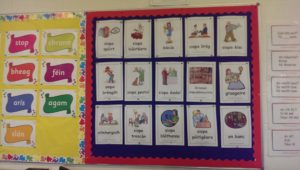Well, we’re half a week past Glenn Cholm Cille, and even though I miss it, Glenn Fhinne has turned out to be just as lovely (Don’t believe me? See picture below!). Because Glenn Fhinne is more remote than Glenn Cholm Cille, the family that I’m staying with gives me every meal. As a result, I’ve gotten to know them pretty well these past few days, and they are wonderful. Our new teachers are also great, and my Irish classes have gotten more intense as I moved up a level to challenge myself this last week.
One thing that makes Irish different from the languages I’ve learned before is that because Irish is a minority language, it’s impossible to study it without also learning about the politics that influence it. I came across an example of a sociopolitical issue surrounding the Irish language this week on an Irish language news website (Tuairisc.ie) in the form of an article on the increase in the number of students in Ireland being educated through the Irish language.
According to the article, as many as 55,000 students in primary and secondary schools are now receiving an immersive Irish language education. What may surprise you, though, is that many of the Irish language schools these students are attending are not national schools (what we would call public schools) in Irish speaking areas, but Gaelscoileanna, Irish language immersion schools, in English-speaking regions.
Although Gaelscoileanna undoubtedly help increase the influence of the Irish language, many people in Ireland see them as negative, because Gaelscoileanna tend to be built in wealthier areas. In addition, admission to Gaelscoileanna is competitive, and some people believe that children with wealthier, better educated parents have a better chance of admission. In short, while those who support Gaelscoileanna say that they are a great help in preserving the Irish language, many people see them as furthering a class divide in Irish society. After reading the Tuairisc article, I wanted to hear firsthand what someone from this Gaeltacht might think about the Gaelscoileanna. Luckily, it turned out that one of the Oideas Gael teachers who grew up in an Irish speaking part of Donegal had actually attended a Gaelscoil in Letterkenny as a teenager. To protect his privacy, I’ll call him Aodhán for the remainder of this post.
Aodhán was familiar with the controversy surrounding Gaelscoilenna, but he said that when he began attending secondary school ten years ago, there was no such concern. Aodhán attended a Gaelscoil in an English-speaking area for secondary school because there was no Irish language secondary school in his town. According to Aodhán, Irish language secondary schools in Gaeltacht areas are relatively rare. This is because many Gaeltacht areas don’t have the population to sustain a high school. For example, there are currently 72 students enrolled in the primary school in Glenn Fhinne. There isn’t enough money to fund a secondary national school for 72 students, because the government would need to pay salaries for around fifteen teachers in order to teach all of the subjects required in the Irish education system.
Aodhán was able to get to Letterkenny because his mother was working there. Most of the students from his primary national school went to one of the two English language secondary schools nearer to his home. As a result, Aodhán said, many of them didn’t have a chance to develop their Irish as they got older. When Aodhán went to the Gaelscoil, it had nothing to do with class divide. It was simply the only place where he could learn his own language.
Nevertheless, Aodhán acknowledged that there are issues with the Gaelscoileanna. The mix of native Irish and native English speakers in them sometimes results in what can be jokingly called “Gaelscoil dialect,” a way of speaking Irish that doesn’t reflect the way native speakers actually use the language. He thought that his use of his native dialect might be weaker because of his education there. In addition, he agreed that Gaelscoileanna are generally built in more affluent areas. He suggests that this might be because new schools in general tend to be built in wealthier areas, a problem we also have in the United States.
I am not from Ireland, and I don’t think that I have a right to an opinion or a conclusion on this issue. Still, I think that it’s worth learning about the political issues surrounding the Irish language, because ultimately politics have a lot to do with whether or not it can survive.
A beautiful afternoon in Glenn Fhinne: Who says it always rains in Ireland?
A poster of Irish phrases in the primary school classroom we’re using for our Oideas Gael course.

